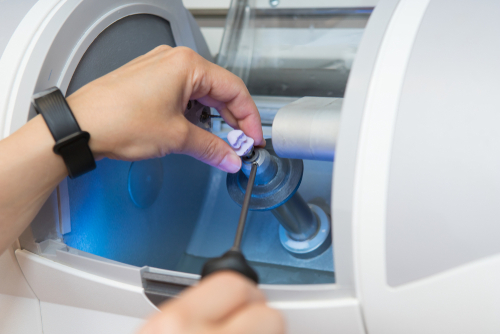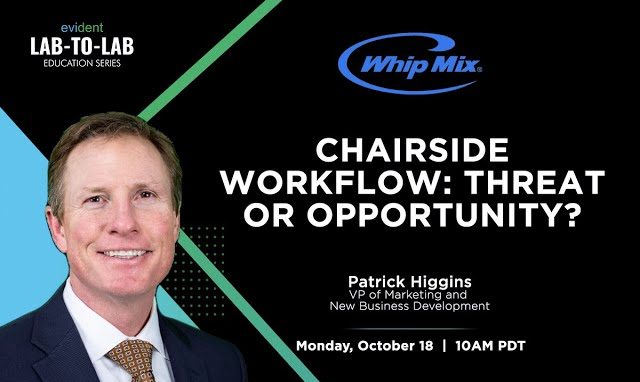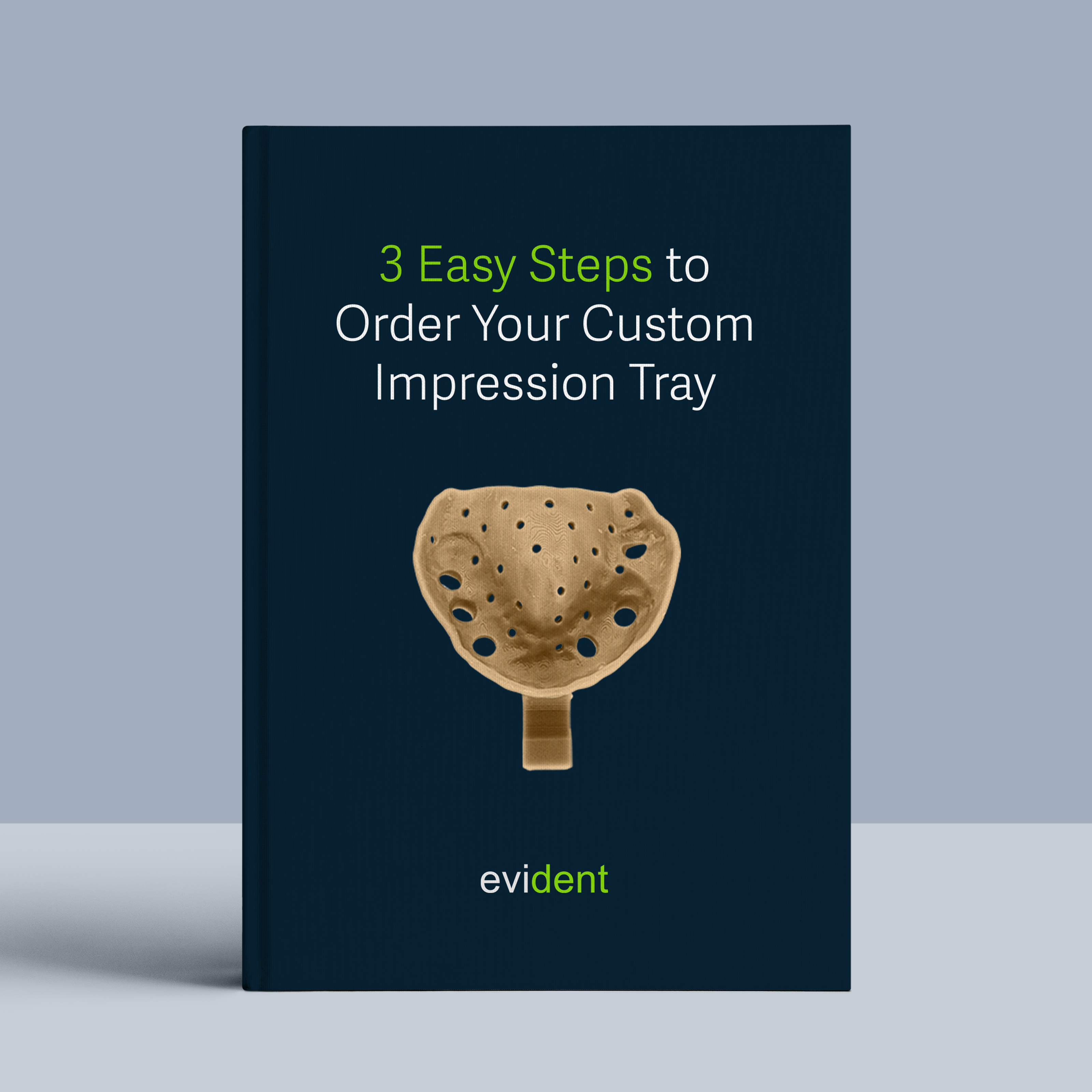
A complete chairside workflow allows dentists to create dental prostheses in just one appointment. With a comprehensive chairside workflow, dentists can scan the patient’s mouth, design the appropriate case, print the design, have it sintered and finished, then pop it into the patient’s mouth, ready for use.
This chairside workflow is great for dental businesses since it provides a better patient experience and reduces their reliance on dental labs. But what does the trend in chairside workflow mean for dental labs? Would dental labs lose business if dentists no longer came to them to fabricate their dental restorations?
Short Answer: No.
This Evident Lab-to-Lab webinar with Patrick Higgins of Whip Mix goes in-depth as to why that is.

A chairside workflow, by its definition, means that every step of the digital restoration should be done in-house, resulting in a quicker turnaround for the patient.
However, a quicker turnaround can still be achieved by doing part of the restoration in-house while still partnering with labs. So, partnering with labs is a great addition to a chairside workflow. Here’s why:
Dental Labs have the Expertise
Dental labs have been manufacturing dental prostheses for the entire duration of their business. The labs don’t typically dabble in hospitality, nursing, or surgery, allowing them to master their restoration fabrications. In addition, dental technology is a different field of study from dentistry.
This gives dental labs the edge in expertise when it comes to designing and manufacturing dental cases. Dental technicians know which resins go with which printers, the different coefficients of expansion of different materials, and much more.
Whereas dentists won’t necessarily have this extensive information, no matter how much support they get from their suppliers.
That said, though dentists may acquire a complete set of equipment that will allow them to produce restorations in-house, labs would still be around to aid with more complex restorations that the dentists may have trouble doing just by themselves.
For example, a lab can mill out a full arch but send it to the clinician to finish it off. Or, a clinician may outsource digital design services to create a final design for the clinician to print in-house.
Dentists Don’t Want To Do Everything On Their Own
They just don’t.
Though some will, there’s still a massive population that isn’t willing to do everything themselves.
Pat Higgins, one of the digital pioneers of Whip Mix, gathered data from dentists from different areas of practice (e.g., orthodontics, prosthodontics, general), interviewing them to see what the barriers are that prevented them from adopting a fully digital, chairside workflow.
Pat found that these roadblocks are cost, lack of chairside fabrication knowledge, and general unfamiliarity with the digital workflow.
Evident’s CEO, Paolo Kalaw, stated that CEREC, a revolutionary digital chairside workflow system, was foreseen to take business away from labs. Paolo then added that CEREC would soon only have roughly a 1% or 2% daily adoption rate among dentists. This statement was made during an Evident webinar interview with Pat.
Pat elaborated, saying that the CEREC system was made to have the dentist do everything in-house. According to Pat, it turns out that the dentist doesn’t really want to do all the designing and fabricating themselves.
Not only is there a tremendous learning curve, but there’s also a lot that the dentist has to do with regard to creating a crown — from design to fabrication and finishing — in their clinic. They’ll need to get more manpower, and they’ll have increased operating expenses, among other things.
So, there’s a preference for outsourcing work to labs, considering that dentists deal with the hospitality side of their practice every day.
A Lab Completes a Chairside Workflow’s Process
Though the adoption rate for chairside processes is still relatively low, that doesn’t mean that the chairside process eliminates the lab’s involvement entirely.
A chairside workflow is simply a means to have all the standard, necessary equipment within reach, allowing for single-appointment restorations. It doesn’t take the lab out of that process. Some chairside systems even incorporate labs, integrating them into the in-house workflow.
Pat mentioned that Whip Mix has created a chairside workflow that, instead of having dentists do everything themselves, integrates the lab into that chairside workflow system.
This system consists of streamlined, fully-compatible software and hardware that work with each other; the IOS scanners, the printers, the hub software, and the resins used all work clockwork with each part of the system.
The clinician’s lab of choice is also integrated into Whip Mix’s chairside system. As a result, labs have a digitized, streamlined working connection with their clinician who avails of the Whip Mix chairside system.
Pat details how that happens in the Whip Mix chairside system:
- When dentists take a scan, the scan file goes into the “Whip Mix Clinic.”
- In the “Whip Mix Clinic” hub, there’s an option to send the IOS scan file immediately to the dental lab of choice.
- The lab receives the IOS scan and designs the case based on the submitted scan and instructions.
- The lab sends the case design back to the dentist.
- Since Whip Mix’s chairside system also comes with a dental 3D printer, dentists have the option to print the returned design in-house.
Whip Mix’s chairside system addresses the primary concerns dentists have with adopting a digital chairside workflow.
They fly an employee to the clinician’s operating space where they help the dentist set up everything and learn what’s needed to get started. In addition, Whip Mix offers a year of technical support for the clinician.
As a result, chairside workflows may see higher adoption rates as more dental manufacturers overcome learning barriers.
In addition, Pat mentioned that they’re getting 10% to 15% more calls from dentists asking for a printer. He continues, saying that the call rate from dentists is growing at an “alarming” rate.
What Should Labs Do?
Technological innovation is inevitable. Digital chairside workflows in the dental industry are no exception. Soon, chairside workflows will become the new standard and will affect those who are unable to adapt (as with any technological innovation).
So, what should labs do?
Printers, scanners, and resins continue to evolve, making dental restoration non-exclusive to labs. Systems, such as Whip Mix’s chairside system, give dentists an intuitive, engaging start to chairside workflows. So, it’s no use resisting this technological push for accessibility and overall better dental care.
Instead, dental labs should embrace this change, not seeing chairside systems as a threat to their operations, but as an opportunity for business growth.
Here’s how:
- Labs should adopt a digital workflow, primarily in the design aspect. This means dedicating teams to file stacking different scans and designing digital cases.
- We recommend labs take the opportunity to be integrated into their dentists’ choice of hub or portal (e.g., 3Shape Communicate, Whip Mix Clinic, etc.). This will make digital workflows more seamless between labs and clinicians.
- Acquire more advanced, top-of-the-line printers and mills — ones that aren’t commonly used in dental clinics. There are several pieces of equipment that dental labs use that dental clinics typically do not, due to differences in the scale of operations and the types of services offered.
Some of this equipment includes industrial 3D printers and high-speed milling machines. Having these tools will allow you to produce more complex restorations, ones that aren’t typically fabricated at the clinic (e.g., all-on-x).
- Automate workflows. Work with software developers to create a digitized and automated workflow for your lab. This improves output, minimizes load on employees, and improves productivity. More importantly, it allows labs to better connect with their dentists.
Here at Evident, we offer lab management software and workflow automation for high-capacity labs. Our automation services allow any lab to run clockwork, even during off hours. Labs can more efficiently gather and organize requests from their partnered clinics, allowing for more optimized operations.
Request a call with Evident now to learn how it works. We tailor our automation solutions for every lab, expanding their capacity and improving their services.
Conclusion
At the end of the day, dental labs shouldn’t be competing with dentists for business. Labs should focus on supplementing dental clinics since that’s where their value lies. Having this philosophy will allow labs to innovate and stay in business, as opposed to resisting significant pushes in the health sector.









